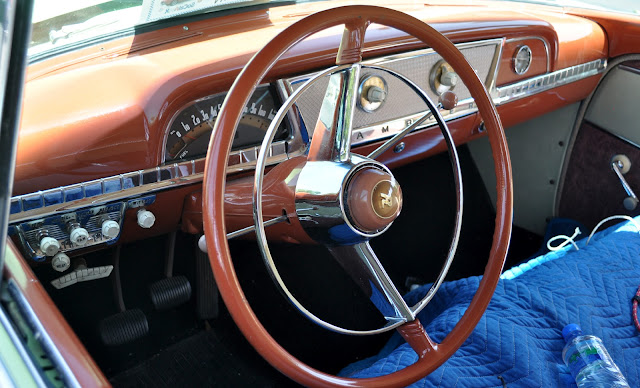The
station wagon (post or hardtop) is an expensive body to make, mainly
because of the large rear quarter panels and roof. The wagon had been
very popular in the Rambler line ever since its intoduction in 1950 as a
two door. A four door version was introduced in 1954 and accounted for
almost one third of Rambler sales that year, and closer to half for
1955.
That there were never any wagons in the other Nash or Hudson lines explains some of the high Rambler wagon sales, but there had to be a wagon in the Rambler line regardless of cost. As it turned out, nearly half the 1956-57 Ramblers sold were wagons. Click Here:
Keep in mind, the 1956 was the 2nd year of AMC existing and so they still used more than one (AMC) car maker identification on this wagon.
That there were never any wagons in the other Nash or Hudson lines explains some of the high Rambler wagon sales, but there had to be a wagon in the Rambler line regardless of cost. As it turned out, nearly half the 1956-57 Ramblers sold were wagons. Click Here:
Keep in mind, the 1956 was the 2nd year of AMC existing and so they still used more than one (AMC) car maker identification on this wagon.
AMC
was created as a merger of Nash and Hudson on May 1, 1954, but Hudson
had no 1955 models ready. Hudson factory production ceased in July of
1954, but AMC had a contractual obligation to supply vehicles to Hudson
dealers until the Nash and Hudson car lines could be consolidated. So
Hudson dealers received the same Rambler as Nash dealers for 1955, the
only difference being the Hudson emblem. U.S. production was 5,981 two
door models, 19,223 four door models. Canadian production was only 226
two door sedans and 548 four door sedans.
Even
at a price that was expensive compared to Ford, Chevrolet and Plymouth,
the Rambler sold well enough to provide the foundation for AMC. It
offered comfortable accomodation for four people, economy, sturdy
contruction and a high level of equipment. It was a foundation that
George Romney, who took over AMC when Mr Mason died in late 1954, would
build upon brilliantly.
Wow, incredible leather seats! And check out the ashtray in the door, cool!
So I looked it up, and was reminded... of just what AMC was. American Motors was a merger of failing car companies that couldn't compete alone against GM, Ford and Chrysler.. The companies that merged were Nash, Hudson the ultimate goal was to be the merger of the new American Motors Corporation with the newly formed Studebaker-Packard Corporation (cash-flush but dealer-poor Packard bought cash-poor but dealer-flush Studebaker), which would have made American Motors a viable four-marque competitor in the industry as one of the "Big Three" - they would have been bigger than Chrysler.
However, when George Mason of AMC died in 1954, James Nance of Studebaker-Packard (took over in 1952) decided to go his own way. He shouldn't have, since the Studebaker-Packard merger was fraught with problems, and the strength of AMC would have bailed them out. As it was, Nance resigned following a disastrous 1956 and Studebaker-Packard agreed to a three-year management contract with the Curtiss-Wright Corporation.
Curtiss-Wright promtly took over all of the defense contracts and factories that Studebaker-Packard held, and killed off Packard within two years, although the Packard name wasn't dropped until 1962.
Source:









